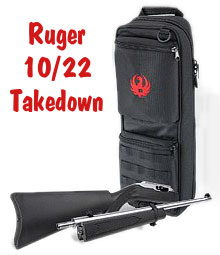 When the Ruger 10/22 was introduced in 1964, perhaps in response to Marlin’s ever-popular Model 60, it took the world of .22 caliber firearms by storm. The Ruger 10/22 is now touted as being the most customized firearm ever. In 1986, the Marlin Model 70 “Papoose” was introduced and the Ruger 10/22 Takedown (hereon simply referred to as the 10/22 TD) has been in existence since March 28, 2012.
When the Ruger 10/22 was introduced in 1964, perhaps in response to Marlin’s ever-popular Model 60, it took the world of .22 caliber firearms by storm. The Ruger 10/22 is now touted as being the most customized firearm ever. In 1986, the Marlin Model 70 “Papoose” was introduced and the Ruger 10/22 Takedown (hereon simply referred to as the 10/22 TD) has been in existence since March 28, 2012.
While there have been quite a few “Takedown” rifles before, including the Marlin 39A lever-action .22 LR rifle, Ruger took its place in the “Takedown” rifle world and has remained one of the take-down “top dogs” ever since. The top competitor, the Marlin Model 70P (commonly known as the Marlin Papoose), which is more related to the AR-7 “Survival Rifle” in style, has garnered its own cult of owners.
I was drawn to the Ruger 10/22 TD, from the beginning of its life, but I already had two 10/22 firearms at the time (a standard synthetic-stocked version [that later became the donor for the Ruger 10/22 International Project] and a full-stock wood “International” version) and felt no need for another Ruger 10/22 firearm. I still feel that there is no need for another Ruger 10/22-based firearm, but I finally succumbed to want and a standard Ruger 10/22 TD found its way into the fold.
Perhaps, the need for the Ruger 10/22 TD version was because of my recent adventures with several Ruger 10/22 projects and my involvement with the Henry AR-7 U.S. “Survival Rifle.”
Regardless, the need was satisfied and what follows is my journey with the Ruger 10/22 TD.
It seems that there is somewhat of a trend these days for highly portable firearms. This trend; however, is nothing new. Many are the shotguns that can be quickly separated into two pieces for easy transport. In fact, many pump shotguns share the same quality, although they are usually kept intact when intended for defensive purposes. The same could be said about the MSR, which separates into two parts by a push of two buttons. Firearms that can be separated and assembled easily do have some advantages over firearms that cannot be separated and assembled easily. But, I digress from the intent of this article and we can banter about that point at some later time.
THE BASICS FOR THOSE WHO DON’T KNOW THEM:
The Model 11100 is the basic Ruger 10/22 TD model.

- Stock: Black Synthetic
- Front Sight: Gold Bead
- Rear Sight: Adjustable
- Material: Stainless Steel
- Barrel Feature: Standard
- Thread Pattern: n/a
- Capacity: 10
- Twist: 1:16″ RH
- Finish: Clear Matte
- Overall Length: 37″
- Barrel Length: 50″
- Weight: 6 lb.
- Grooves: 6
- Suggested Retail: $439.00
- Easy takedown enables quick separation of the barrel from the action for ease of transportation and storage. Takedown is as simple as locking the bolt back and verifying that the rifle is unloaded, pushing a recessed lever, twisting the subassemblies and pulling them apart.
- Simple reassembly allows for a secure connection of the barrel and action and returns the firearm to zero, even when receiver-mounted optics are used, ensuring consistent accuracy, shot after shot.
- Patented, detachable 10-round rotary magazine features a unique rotor to separate cartridges and provide reliable feeding.
- Legendary action, a tried and true Ruger design, ensures consistent, reliable performance.
- Combination scope base adapter for both Weaver-style and .22 tip-off scope mounts included.
- Easy-to-use extended magazine release provides smooth, no-fuss removal of flush-mounted magazine
- Positive, push-button, cross-bolt manual safety.
- Heat-stabilized, glass-filled, polymer trigger housing assembly is precision-made of high-tech material for improved manufacturing tolerances, impact and abrasion-resistance and unmatched ability to withstand the elements.
Precision-rifled, cold hammer-forged barrel. - Also includes: Convenient carry-case, which provides ample storage room for magazines and accessories.
WHAT WE HAVE HERE…
The Ruger 10/22 TD is presented in quite a few configurations to include: Mossy Oak® Break-Up Camo, Threaded Barrel with Flash Suppressor, Alloy steel and stainless steel, 920″ Diameter threaded and fluted target barrel, standard and laminated wood stock, and so forth. Accessories for the 10/22 rifle are in abundance for the Ruger 10/22 and 10/22 TD firearms, which are probably the most customized firearms short of the MSR in the long-gun category.
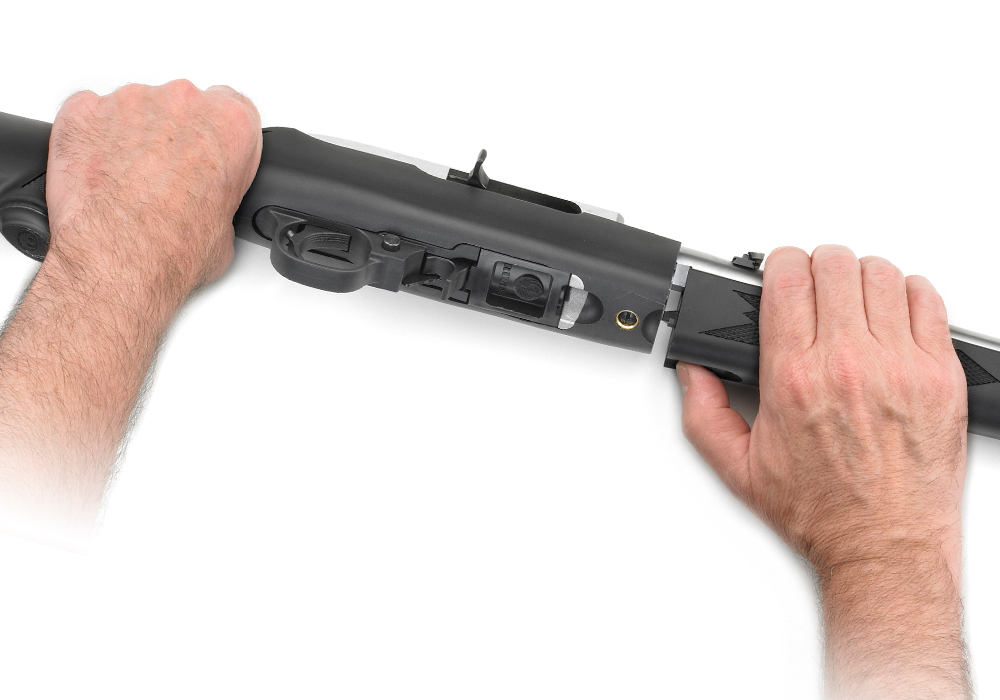 But, what we have here is simply a carbine-length firearm that can be separated into two parts and it is no more than that. It is not a specialized “Survival” or “Tactical” firearm, although I suppose it can be used in that sense. Aside from the fact that it can be separated into two parts, it is no different from other Ruger 10/22 firearms that share a common receiver, action, and magazine design – including the Ruger SR-22 and Ruger Charger.
But, what we have here is simply a carbine-length firearm that can be separated into two parts and it is no more than that. It is not a specialized “Survival” or “Tactical” firearm, although I suppose it can be used in that sense. Aside from the fact that it can be separated into two parts, it is no different from other Ruger 10/22 firearms that share a common receiver, action, and magazine design – including the Ruger SR-22 and Ruger Charger.
The Ruger 10/22 TD comes in a variety of configurations and stock options; most notably from Accu-Sports, Gallery of Gun, and others. I wanted the basic model; a stainless-steel barrel and black synthetic stock, of which only the barrel and action would serve as a donor for a build of my own desire.
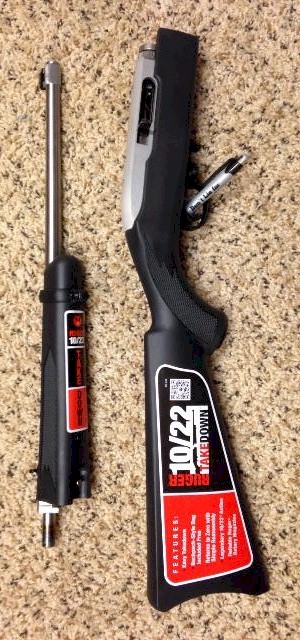 What we also have here is Ruger’s propensity to slap stickers on almost every inch of the stock much to the consternation of those who will never recover the amount of time spent removing the stickers when they really decide to stick. Ruger, you have a brochure showing how to assemble and disassemble the darn thing! Could you not just include it wrapped in a rubber band around the forearm, or perhaps something better that does not need Goo-Be-Gone to clean up the residue left by your stickers? With the exception of sticker glue residue, the black composite stock is made of a thermoplastic polyester resin that is resistant to the elements.
What we also have here is Ruger’s propensity to slap stickers on almost every inch of the stock much to the consternation of those who will never recover the amount of time spent removing the stickers when they really decide to stick. Ruger, you have a brochure showing how to assemble and disassemble the darn thing! Could you not just include it wrapped in a rubber band around the forearm, or perhaps something better that does not need Goo-Be-Gone to clean up the residue left by your stickers? With the exception of sticker glue residue, the black composite stock is made of a thermoplastic polyester resin that is resistant to the elements.
As I mentioned earlier, I had an earlier version of the same firearm that was used as a donor for the 10/22 “International” project. However, the synthetic stock on the earlier version was much better quality than what was found with the newer version. For those who desire a better stock can certainly find one (I did), but that should be an option and not a necessity, in my line of thinking.
THE NOT SO COVERT TRANSPORT FACTOR:
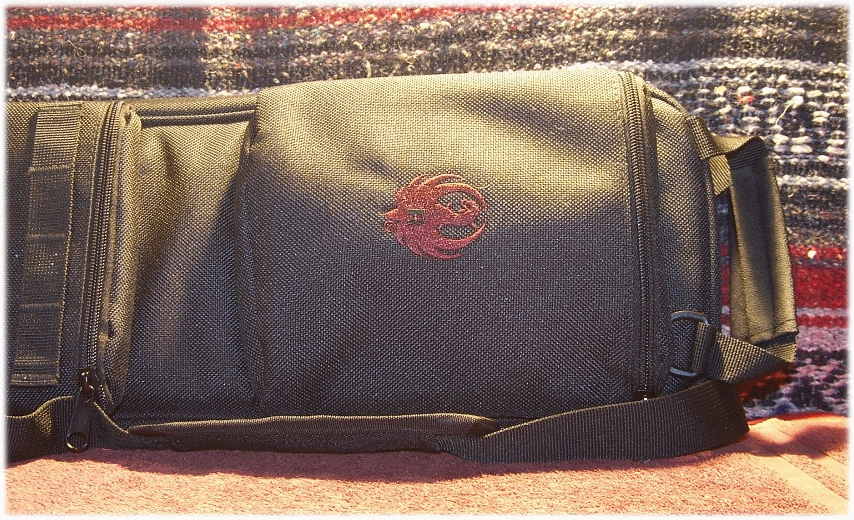 Ruger provides a nice carrying case for the 10/22 TD that has more than enough pockets and space to house not only the 10/22 TD, but myriad of articles and ammunition. If covert carry of the 10/22 TD is one of your ambitions, the large red Ruger logo on the bag may detract from your ambition (I used a black “Sharpie” on the logo, which muted it to somewhat of a burgundy color). The use of the bag I leave up to the owner. Except when traveling, the 10/22 TD is stored assembled and in a suitable Bore Store for maximum protection in the safe. I won’t go into how I transport the 10/22 TD, but let’s just say that I have other, and more covert, means to do so than in the Ruger bag.
Ruger provides a nice carrying case for the 10/22 TD that has more than enough pockets and space to house not only the 10/22 TD, but myriad of articles and ammunition. If covert carry of the 10/22 TD is one of your ambitions, the large red Ruger logo on the bag may detract from your ambition (I used a black “Sharpie” on the logo, which muted it to somewhat of a burgundy color). The use of the bag I leave up to the owner. Except when traveling, the 10/22 TD is stored assembled and in a suitable Bore Store for maximum protection in the safe. I won’t go into how I transport the 10/22 TD, but let’s just say that I have other, and more covert, means to do so than in the Ruger bag.
SEPARATION ANXIETY:
The key feature of the 10/22 TD is the simplicity of disassembly and assembly of the two-halves.
 A simple forward push of a pin that is located on the bottom side of the forward half, a twist, a pull, and the 10/22 is in two pieces. Of course, this is after the bolt has been locked to the rear and the 10/22 is unloaded and safe. Assembling the two halves is just as quick, and as with disassembly, the bolt must be locked to the rear to do so.
A simple forward push of a pin that is located on the bottom side of the forward half, a twist, a pull, and the 10/22 is in two pieces. Of course, this is after the bolt has been locked to the rear and the 10/22 is unloaded and safe. Assembling the two halves is just as quick, and as with disassembly, the bolt must be locked to the rear to do so.
 There is an adjustment knob that has to be adjusted when assembling the 10/22 TD for the first time, but only needs to be checked occasionally afterward. The adjustment knob is used to tighten the barrel assembly and the receiver assembly; there should be no play when the two halves come together and are locked into place.
There is an adjustment knob that has to be adjusted when assembling the 10/22 TD for the first time, but only needs to be checked occasionally afterward. The adjustment knob is used to tighten the barrel assembly and the receiver assembly; there should be no play when the two halves come together and are locked into place.
There is also a note from Ruger:
NOTE: Following barrel installation, best fired shot accuracy will be achieved if the action is dry- cycled prior to actually firing ammunition in the rifle: Remove the magazine from the rifle and be certain the chamber is empty. Keeping the rifle pointed in a safe direction, pull the bolt handle fully to the rear while holding the bolt lock up, then release the bolt handle, letting it “slingshot” (freely fly forward) into the ready-to-fire position. Repeat 2 – 3 times. This will properly “seat” the barrel assembly.
RUGER RUGGED:
The 10/22 TD, like other Ruger products, is “Ruger Rugged” and the TD feature does not sway from that. When the 10/22 TD is properly and fully assembled, it feels just as solid as the non-TD counterparts. The synthetic stock is well-formed and well-patterned in all of the right places. There have been some complaints regarding the barrel band of the 10/22, but considering that the barrel can be removed from the rifle, and the barrel band does not have to be removed from the rifle unless the forearm is to be removed, the barrel band is a non-issue in my book.
SAME OLD, SAME OLD:
The receiver and trigger is the same as on any other 10/22. There has been no improvement in the trigger and it is still “Ruger Robust.”
The front and rear sights are also the same as can be found on other 10/22 firearms. Unless you have old eyes like mine, the sights are adequate for most people. But, just in case the sights don’t work for you, Ruger provides a sight base that can be quickly installed and upon which you can mount your favorite optic – magnified or not. There is more on this in OPTICAL DELUSIONS.
The standard 10-round rotary magazine is still present and the 10/22 TD also accepts large-capacity magazines regardless of what state you live in.
The 10/22 TD does not come with sling swivels, which is not any different from other base-models of the 10/22; however, Ruger does sell a sling and swivel set for the 10/22, and sling swivels are also available from third-party vendors.
The Ruger 10/22 TD also retains the 13.5-inch LOP, which is shorter than my liking, but a slip on recoil pad can extend the LOP if one absolutely needs it.
In other words, don’t expect any surprises or improvements other than the ability to separate the firearm into two halves.
NOPE! PERFORMANCE HAS NOT IMPROVED:
If you are expecting any performance improvement over other 10/22 firearms, that is not going to happen. On the same token, performance has not lessened. I was concerned with the rifle holding accuracy with the front end of the rifle, the end that holds the rear and front sight, which would be on and off of the firearm. There was no cause for concern; however, the 10/22 TD seemed to hold on target just fine. Running an optic is also of no concern, unless you remove the optic itself. Even then, I found the zero to be more than close. In most cases, I have to add a click or two of adjustment every time that I shoot with an optic on any other firearm; the 10/22 TD is no exception.
ROOM FOR IMPROVEMENT:
The Ruger 10/22, regardless of the model, begs for improvement. I am happy to oblige.
The first improvement was the trigger. The standard trigger was replaced with a BX-Trigger unit that I already had, which provides a very clean and crisp 3.5 pound trigger pull with just a hint of take-up and no over-travel. The BX-trigger unit was also equipped with an extended Tactical Solutions magazine release (in silver to compliment the silver-colored forged aluminum receiver. A Volksquartzen Auto-Release Bolt Lock had been installed on a previous occasion, which makes locking and releasing the bolt less stressful.
The steel Bolt Stop Pin was also replaced with a polyurethane unit to quiet the action and to protect the receiver from the bolt.
I wanted a better choice of optic mounting than the Ruger-provided optic mounting rail provides. A Ruger Picatinny rail had been ordered separately and was quickly mounted with the provided screws. The Picatinny rail adds a much lower profile to the 10/22 TD than the standard Ruger sight base.
One major change that took place is the stock. Now, I could have gone all willy-nilly on a stock. There are many, many fine stocks for the 10/22 TD in beautifully patterned laminate – with and without thumbholes, and also stocks in custom made hardwood. Since I am a dedicated introvert, I wanted a stock that would be appealing, not too outlandish, and would reflect my personality. For the stock, I selected the Hogue Rubber OverMolded Rifle Stock Ruger 10/22 Takedown Standard Barrel Channel Synthetic in Ghillie Green, which appealed to my “earth child” for some reason. No modifications are necessary, but I do not get to keep the barrel band, which some folks would rather not keep anyway. The Hogue stock’s LOP is 13 ¾ inches, which is ½” longer than the standard stock, and I like the longer LOP, although I wanted to keep the length intact for carrying the 10/22 TD in Ruger’s magnificent carrying bag with a mounted optic.
Hopefully, only having one screw to mount the barrel to the forearm does not destabilize the barrel; I have had my barrel destabilized on enough occasions and prefer that my barrel is rigid when mounted.
Author’s Note: Contrary to some beliefs, the barrel of the 10/22 TD is not “free floating” as some imagine it to be. The slight play at the forearm; however, may help alleviate any stock stress on the barrel after prolonged firing. The 10/22 standard target barrel is well known for a somewhat loss of accuracy after prolonged firing, and if a loose forearm helps in the accuracy department, then I am all for it.
The Hogue stock and forearm assembly is nicely matched and presents a tight fit for both receiver and barrel. Note the spacing between the extended magazine release lever and the trigger guard; this is normal with a magazine installed. Without the magazine, the extended magazine lever is flush with the trigger guard. As the 10/22 TD is intended for field use, and more than occasional range trips. The Hogue stock turned out to be a good choice, and I like the more substantial feel of the stock over what Ruger provides, but at 1.88 pounds it does weigh more than the standard stock.
The only negative that I have with the stock is that there is a little less of the takedown lever to work with, since the Hogue stock is thicker than the standard stock; it is however, very workable.
Author’s Note: You can read more about the Hogue stock on the Ruger 10/22 TD @ Hogue Ghillie Green Rubber OverMolded Stock for 10-22 Takedown Standard Barrel: https://guntoters.com/blog/2017/03/24/hogue-ghillie-green-rubber-overmolded-stock-for-10-22-takedown-standard-barrel/
So, here we are at this point:
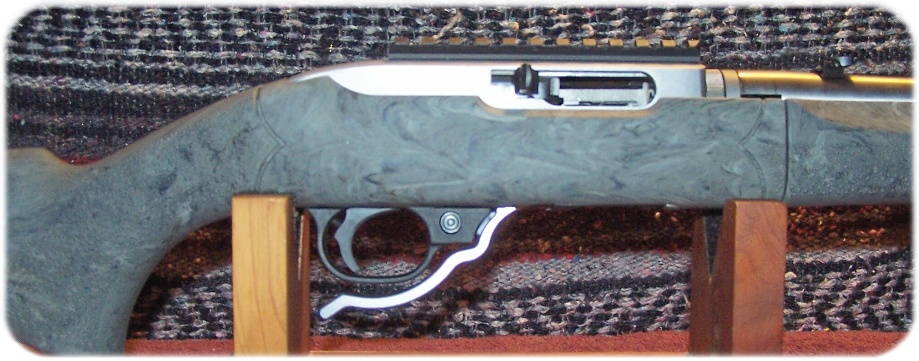
OPTICAL DELUSIONS:
With my eyesight, an optic, magnified or not, is a definite improvement over the open sights that are provided with the 10/22 TD – any 10/22 firearm, in fact.
To add to the equation, I opted to use the Ruger Picatinny rail rather than the standard issue Ruger 10/22 rail. I wanted a few more options for mounting optics, and after pouring over reviews and other scope literature, I just happened to have a number of different optics in mind.
While I really would like to take you through this journey in this article, the results of my experimentation warranted a separate article because there were five different optics involved from which only one would be chosen.
You can read about the Ruger 10/22 TD scope project @ The Ruger 10/22 Takedown Optics Project Mine Eyes Hath Seen the Glory – And not so glorious!: https://guntoters.com/blog/2017/03/26/the-ruger-1022-takedown-optics-project/
RANGE DAY:
The Ruger 10/22 TD was finally ready for the range, and so was I. There are two large groups that I am uncomfortable with; large groups of people, and large groups on the target. The first group I can eliminate by isolating myself in the shooting lane. The second group takes some concentration and good marksmanship practices to eliminate.
A one-hundred yard sight-in target was posted some twenty-five yards distant; a ten-round magazine was loaded with five rounds of CCI 40-grain Mini-Mag, and off we went to zero the package.
Author’s Note: Range day has subsequently turned into range “days” with different optics being tried out. With that said, I end this article with the latest 10/22 TD optics package, and simply move on to observations taken at the range..
There were no malfunctions during the course of fire, except for mine. After the course of fire was completed, the 10/22 TD was separated into its two halves, the front half was run through several times with a Bore Snake, and the entire package was stored in the bag from whence it came for transport back home, a thorough cleaning, and a check of screw tightness with a torque tool.
I did have to adjust the barrel Adjustment knob two clicks to tighten the barrel further after the shooting session. Even Ruger advises checking the barrel tightness after prolonged firing. The 10/22 TD was new and things just have to find their rightful place.
This particular 10/22 TD seems to like CCI Min-Mag ammunition and I’ll leave it at that. The operator of the 10/22 TD, like any other firearm, needs to find what works in his or her particular firearm according to their expectations. I’ll be experimenting with other ammunition in the future.
A mention about the Ruger BX-Trigger needs to be made. AT the present time, the Ruger BX-Trigger is the least expensive of trigger modifications that can be made for the 10/22. It is a good trigger and takes the 10/22 to a higher level than with the stock trigger. My Volquartsen-modified 10/22 trigger units; however, are better triggers with a crisper break and less trigger pull weight. With that said, modifying a stock Ruger 10/22 trigger with Volquartsen parts is a more expensive proposition than simply using the Ruger BX-Trigger. The operator of a Ruger 10/22 will have to decide if the standard trigger is “good enough” or if they want more out of the trigger. The Ruger BX-Trigger that I was using was new and still stiff; I expect it to break in nicely with use.
THE FINAL TAKE:
What I have here, with the Ruger 10/22 TD build, is a somewhat compact package that went from 4.6 pounds (according to Ruger) to roughly 7.5 pounds with the stock and optic improvements. But, one has to consider that a Ruger 10/22 standard carbine with wood stock and stainless-steel target barrel (for example. the Ruger 10/22 Deluxe Sporter) weighs in at 5.7 pounds. Add a Hogue stock and my scope and ring combination, and the Ruger 10/22 TD would weigh about the same if not less, but it can be separated into two pieces; whereas the standard 10/22 cannot.
As far as optics? You can read about that decision in The Ruger 10/22 Takedown Optics Project Mine Eyes Hath Seen the Glory – And not so glorious!: https://guntoters.com/blog/2017/03/26/the-ruger-1022-takedown-optics-project/
Although the Hogue stock is longer than what Ruger provided, the stock will still fit in the Ruger bag enough to zip the back closed. The flap for the stock can be secured with the Velco fasteners, but just barely. The barrel assembly fits fine, which leaves one inside pouch for Slim Jim snacks and two outside pouches for whatever your needs. The latest scope configuration can also be stored in the main bag with the 10/22 TD, but not attached to the firearm.
What I can say about the Ruger 10/22 TD is that I thoroughly enjoy shooting it, as I do with any 10/22 based firearm after my upgrades. Your choice of storage solutions I leave entirely up to you. The way that I see it, you are; going to store the Ruger 10/22 TD short and wide (in the provided bag), or tall and skinny (somewhere). I consider the bag a temporary way to store the 10/22 TD for transportation purposes only; I store the 10/22 TD fully assembled in a Bore Store for protection.
The one very positive thing that I can say about the Ruger 10/22 TD is that it makes cleaning the barrel an easy task, compared to an attached barrel. And, the take-down and assembly of the Ruger 10/22 TD is faster than the Henry AR-7 and is definitely faster than with the Marlin Model 70 Papoose.
With a Ruger BX-Trigger, or trigger unit of your choice, and a few easy drop-in modifications, the Ruger 10/22 TD is fun to shoot and less aggravating to operate the controls. Compared to my other 10/22 “projects,” this one is going to see a lot of use.
If you decide to purchase a 10/22 TD, I don’t believe that you would regret it. You can shoot it fast, or you can shoot it slow; this little puppy just keeps on chugging the rounds out. If you need to pack it out, the Ruger-provided bag can accommodate the 10/22 TD, spare parts, ammunition, and lubricant such as the oil on your fingers after consuming long Slim-Jim snacks (about a dozen long Slim Jims can be stored in the bag in the pouch that is alongside the barrel storage pouch).
Of course, the 10/22 TD, like other 10/22-based firearms, can be customized to your fancy. With that said, I can highly recommend the Ruger BX-Trigger as a top priority item followed by a Volksquartzen automatic bolt release and an extended magazine release of your choice. For me, an optic these days are a definite plus. With these improvements, my experience with the 10/22 TD is más agradable (more enjoyable).
With all this said, some folks will like to play with the 10/22 TD as it is out of the box, and it does just fine in that respect.
DON’ JUS’ TAKE MY WORD FOR IT:
There are many reviews on the Ruger 10/22 TD, and I only list favorites here:
- Ruger 10/22 TD Model (Hickok45): https://www.youtube.com/watch?v=tVnxf73KKks
- Ruger 10-22 Take-Down Model (Chapter 2 ): https://www.youtube.com/watch?v=B3QFSdKrevU
- Ruger 10/22-TD Take-Down 22 Semi-Automatic Rifle – Gunblast.com: https://www.youtube.com/watch?v=xMWTN-xQo_g
A web search will reveal many more that can possibly be listed here.
RESOURCES:
- Ruger 10/22 TD (model 11100): http://www.ruger.com/products/1022TD/specSheets/11100.html
- Ruger BX-Trigger: http://www.brownells.com/search/index.htm?k=ruger+bx-trigger&ksubmit=y
- Ruger BX-Trigger Videos: http://ruger.com/micros/BX-Trigger/?r=y
- Ruger BX-Trigger Video review by Jeff Quinn @ gunblast.com: https://www.youtube.com/watch?v=pSJBBT1BfP4&feature=youtu.be
- Volquartsen Automatic Bolt Release Ruger 10/22: http://www.midwayusa.com/product/688102/volquartsen-automatic-bolt-release-ruger-10-22?cm_mmc=se_service-_-shippingconf-_-shippingconf-_-ProductShippedTodayLink
- Power Custom Competition Extended Magazine Release Ruger 10/22 Aluminum: https://www.midwayusa.com/product/160459/power-custom-competition-extended-magazine-release-ruger-10-22-aluminum
- Tuffer Buffer (bolt stop buffer pin): http://www.tufferbuffer.com/
- Hogue Rubber OverMolded Rifle Stock Ruger 10/22 Takedown Standard Barrel Channel Synthetic: https://www.midwayusa.com/product/772019/hogue-rubber-overmolded-rifle-stock-ruger-10-22-takedown-standard-barrel-channel-synthetic Author’s Note: Read my review about this stock @ Hogue Ghillie Green Rubber OverMolded Stock for 10-22 Takedown Standard Barrel: https://guntoters.com/blog/2017/03/24/hogue-ghillie-green-rubber-overmolded-stock-for-10-22-takedown-standard-barrel/
![]()

